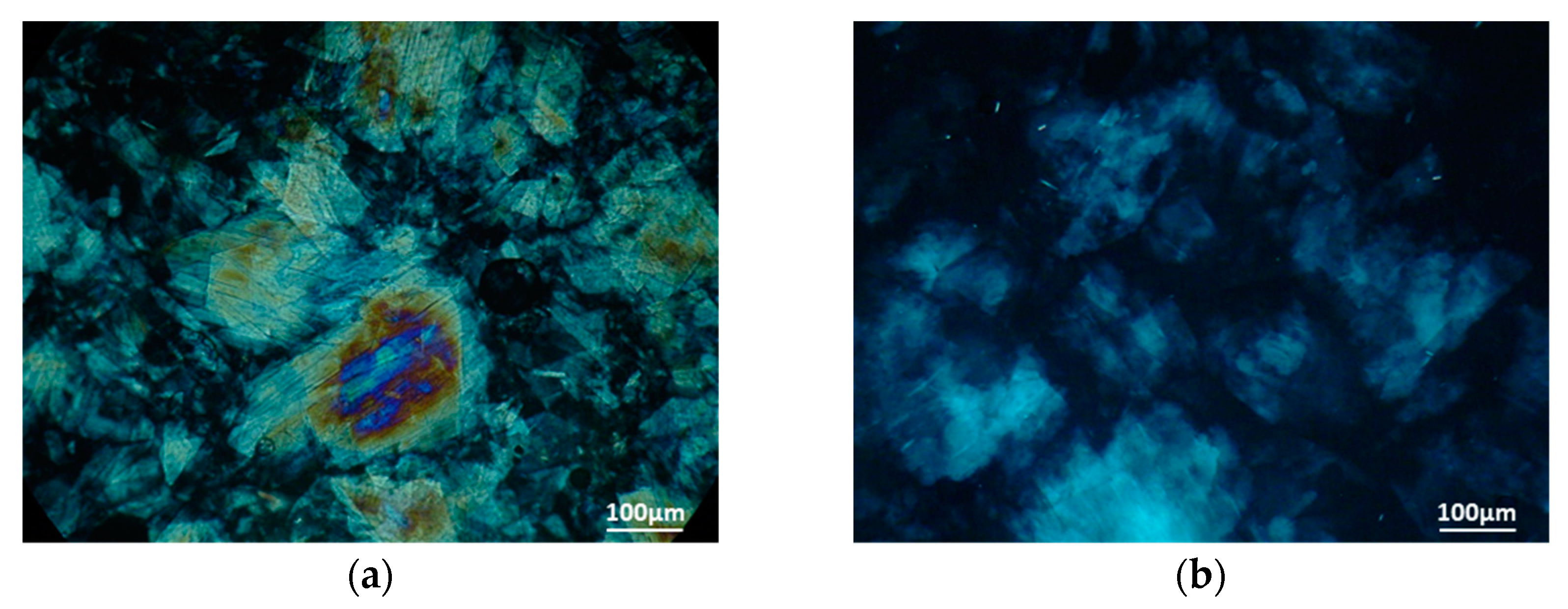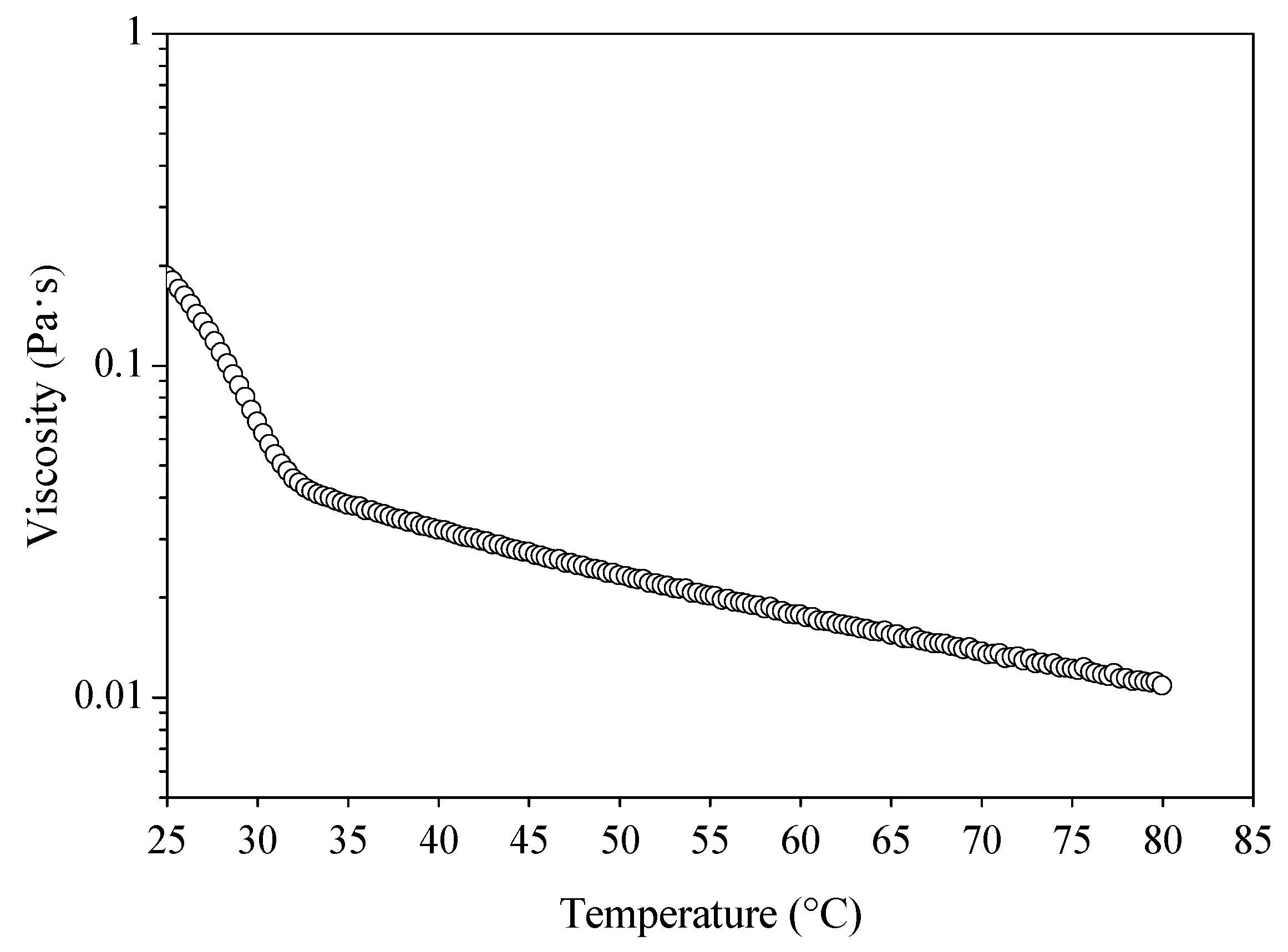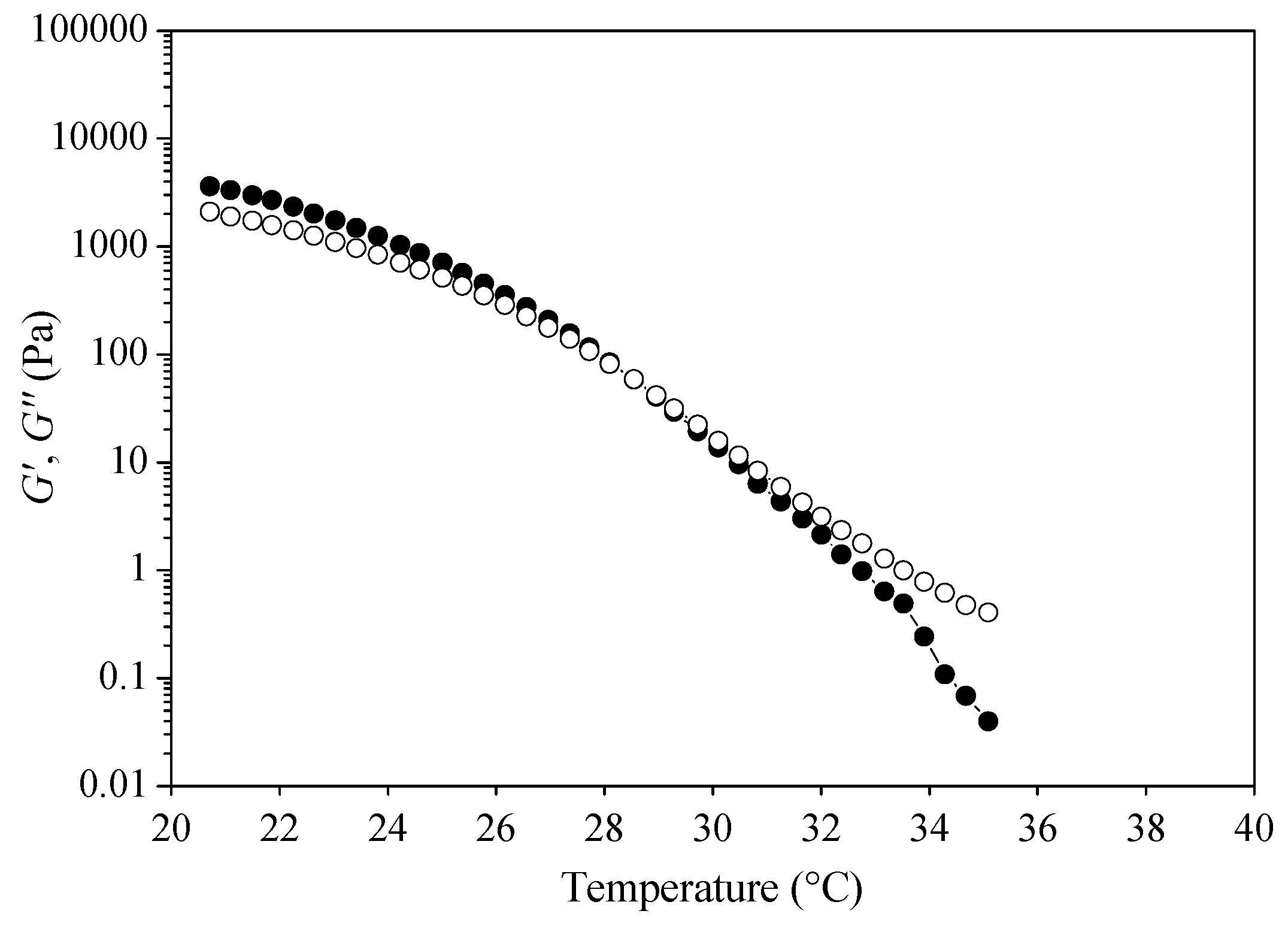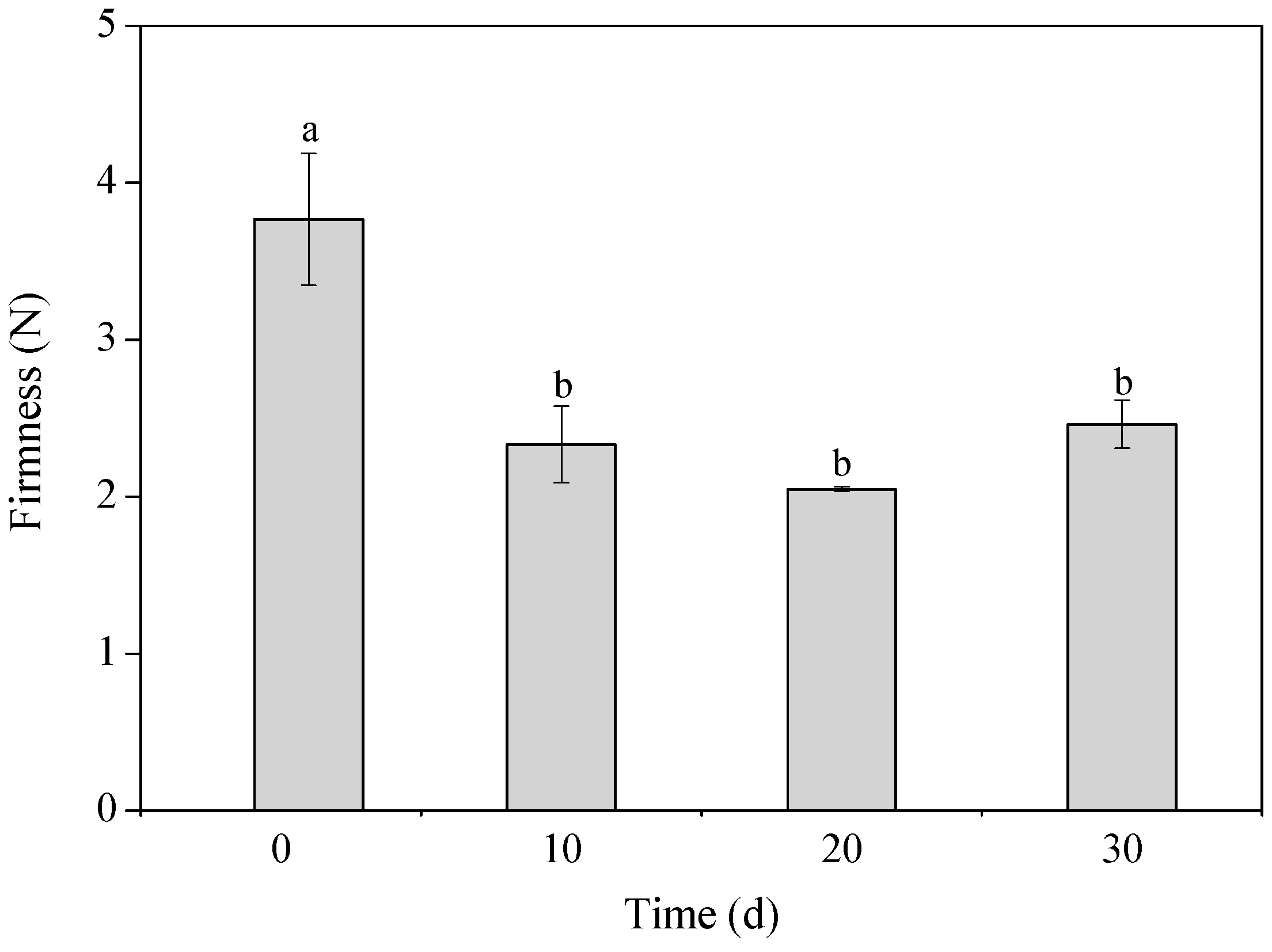Olive Oil Oleogel Formulation Using Wax Esters Derived from Soybean Fatty Acid Distillate
Abstract
1. Introduction
2. Materials and Methods
2.1. Raw Materials
2.2. Enzymatic Synthesis of Wax Esters
2.3. Oleogel Preparation
2.4. Analytical Methods
2.4.1. Crystal Morphology
2.4.2. Color Analysis
2.4.3. Rheological Analysis
2.4.4. Texture Analysis
2.4.5. Melting Behavior
2.5. Statistical Analysis
3. Results and Discussion
3.1. Olive Oil Oleogel Production
3.2. Microstructure Analysis
3.3. Color and Melting Temperatures Analysis
3.4. Rheological Properties
3.5. Textural Properties
4. Conclusions
Author Contributions
Funding
Acknowledgments
Conflicts of Interest
References
- Centre for Economics and Business Research, CEBR. The Economic Cost of Cardiovascular Disease from 2014–2020 in Six European Economies. Available online: http://www.sanita24.ilsole24ore.com/pdf2010/Sanita2/_Oggetti_Correlati/Documenti/Dibattiti-e-Idee/3Cebr%20-%20The%20economic%20cost%20of%20cardiovascular%20disease%20from%202014-2020%20in%20six%20European%20economies.pdf?uuid=AbV1x4QK (accessed on 19 May 2018).
- WHO/FAO. Diet, Nutrition and the Prevention of Chronic Diseases: Report of a Joint WHO/FAO Expert Consultation; WHO Technical Report Series; WHO: Geneva, Switzerland, 2003; No. 916. [Google Scholar]
- U.S. Food and Drug Administration. Final Determination Regarding Partially Hydrogenated Oils (Removing Trans Fat). Available online: https://www.fda.gov/food/food-additives-petitions/final-determination-regarding-partially-hydrogenated-oils-removing-trans-fat (accessed on 10 November 2019).
- Singh, A.; Auzanneau, F.-I.; Rogers, M.A. Advances in edible oleogel technologies—A decade in review. Food Res. Int. 2017, 97, 307–317. [Google Scholar] [CrossRef]
- Martins, A.J.; Vicente, A.A.; Cunha, R.L.; Cerqueira, M.A. Edible oleogels: An opportunity for fat replacement in foods. Food Funct. 2018, 9, 758–773. [Google Scholar] [CrossRef]
- Mao, L.; Lu, Y.; Cui, M.; Miao, S.; Gao, Y. Design of gel structures in water and oil phases for improved delivery of bioactive food ingredients. Crit. Rev. Food Sci. Nutr. 2019. [Google Scholar] [CrossRef] [PubMed]
- Doan, C.D.; Tavernier, I.; Okuro, P.K.; Dewettinck, K. Internal and external factors affecting the crystallization, gelation and applicability of wax-based oleogels in food industry. Innov. Food Sci. Emerg. Technol. 2018, 45, 42–52. [Google Scholar] [CrossRef]
- Demirkesen, I.; Mert, B. Recent developments of oleogel utilizations in bakery products. Crit. Rev. Food Sci. Nutr. 2019. [Google Scholar] [CrossRef] [PubMed]
- Dassanayake, L.S.K.; Kodali, D.R.; Ueno, S.; Sato, K. Physical properties of rice bran wax in bulk and organogels. J. Am. Oil Chem. Soc. 2009, 86, 1163–1173. [Google Scholar] [CrossRef]
- Öǧütcü, M.; Yilmaz, E. Oleogels of virgin olive oil with carnauba wax and monoglyceride as spreadable products. Grasas Aceites 2014, 65, 40. [Google Scholar] [CrossRef]
- Öǧütcü, M.; Arifoğlu, N.; Yilmaz, E. Preparation and characterization of virgin olive oil-beeswax oleogel emulsion products. J. Am. Oil Chem. Soc. 2015, 92, 459–471. [Google Scholar] [CrossRef]
- Yılmaz, E.; Öğütcü, M. Comparative analysis of olive oil organogels containing beeswax and sunflower wax with breakfast margarine. J. Food Sci. 2014, 79, E1732–E1738. [Google Scholar] [CrossRef]
- Yilmaz, E.; Öǧütcü, M. Oleogels as spreadable fat and butter alternatives: Sensory description and consumer perception. RSC Adv. 2015, 5, 50259–50267. [Google Scholar] [CrossRef]
- Papadaki, A.; Cipolatti, E.P.; Aguieiras, E.C.G.; Pinto, M.C.C.; Kopsahelis, N.; Freire, D.M.G.; Mandala, I.; Koutinas, A.A. Development of microbial oil wax-based oleogel with potential application in food formulations. Food Bioprocess. Tech. 2019, 12, 899–909. [Google Scholar] [CrossRef]
- Nagavekar, N.; Kumar, A.; Dubey, K.; Singhal, R.S. Supercritical carbon dioxide extraction of kokum fat from Garcinia indica kernels and its application as a gelator in oleogels with oils. Ind. Crops Prod. 2019, 138, 111459. [Google Scholar] [CrossRef]
- Gómez-Estaca, J.; Pintado, T.; Jiménez-Colmenero, F.; Cofrades, S. Assessment of a healthy oil combination structured in ethyl cellulose and beeswax oleogels as animal fat replacers in low-fat, PUFA-enriched pork burgers. Food Bioprocess. Technol. 2019, 12, 1068–1081. [Google Scholar] [CrossRef]
- Gómez-Estaca, J.; Herrero, A.M.; Herranz, B.; Álvarez, M.D.; Jiménez-Colmenero, F.; Cofrades, S. Characterization of ethyl cellulose and beeswax oleogels and their suitability as fat replacers in healthier lipid pâtés development. Food Hydrocol. 2019, 87, 960–969. [Google Scholar] [CrossRef]
- Aguieiras, E.C.G.; Papadaki, A.; Mallouchos, A.; Mandala, I.; Homero, S.; Freire, D.M.G.; Koutinas, A.A. Enzymatic synthesis of bio-based wax esters from palm and soybean fatty acids using crude lipases produced on agricultural residues. Ind. Crops Prod. 2019, 139, 111499. [Google Scholar] [CrossRef]
- Papadaki, A.; Mallouchos, A.; Efthymiou, M.-N.; Gardeli, C.; Kopsahelis, N.; Aguieiras, E.C.G.; Freire, D.M.G.; Papanikolaou, S.; Koutinas, A.A. Production of wax esters via microbial oil synthesis from food industry waste and by-product streams. Bioresour. Technol. 2017, 245, 274–282. [Google Scholar] [CrossRef]
- Papadaki, A.; Kopsahelis, N.; Mallouchos, A.; Mandala, I.; Koutinas, A.A. Bioprocess development for the production of novel oleogels from soybean and microbial oils. Food Res. Int. 2019, 126, 108684. [Google Scholar] [CrossRef]
- Hartel, R.W.; von Elbe, J.H.; Hofberger, R. Fats, Oils and Emulsifiers. In Confectionery Science and Technology; Springer: Cham, Switzerland, 2018; pp. 85–124. [Google Scholar]
- Wijarnprecha, K.; Aryusuk, K.; Santiwattana, P.; Sonwai, S.; Rousseau, D. Structure and rheology of oleogels made from rice bran wax and rice bran oil. Food Res. Int. 2018, 112, 199–208. [Google Scholar] [CrossRef]
- Si, H.; Cheong, L.-Z.; Huang, J.; Wang, X.; Zhang, H. Physical properties of soybean oleogels and oil migration evaluation in model praline system. J. Am. Oil Chem. Soc. 2016, 93, 1075–1084. [Google Scholar] [CrossRef]
- O’Brien, R.D. Fats and Oils Formulation. In Fats and Oils: Formulating and Processing for Applications, 3rd ed.; CRC Press: Boca Raton, FL, USA, 2008; pp. 263–346. [Google Scholar]
- Tavernier, I.; Doan, C.D.; de Walle, D.V.; Danthine, S.; Rimaux, T.; Dewettinck, K. Sequential crystallization of high and low melting waxes to improve oil structuring in wax-based oleogels. RCS Adv. 2017, 7, 12113. [Google Scholar] [CrossRef]
- Gaudino, N. Development of Lecithin-Based Oleogels and Oleogel Emulsions with Stearic Acid Capable of Enhancing Probiotic Viability and Delaying Oxidation. Graduate’s Thesis, Iowa State University, Ames, IA, USA, 2018; p. 17189. Available online: https://lib.dr.iastate.edu/etd/17189 (accessed on 28 November 2019).
- Mai, T.H.A.; Tran, V.N.; Le, V.V.M. Biochemical studies on the immobilized lactase in the combined alginate–carboxymethyl cellulose gel. Biochem. Eng. J. 2013, 74, 81–87. [Google Scholar] [CrossRef]
- Nagayama, K.; Yamasaki, N.; Imai, M. Fatty acid esterification catalyzed by Candida rugosa lipase in lecithin microemulsion-based organogels. Biochem. Eng. J. 2002, 12, 231–236. [Google Scholar] [CrossRef]
- Lee, M.C.; Tan, C.; Abbaspourrad, A. Combination of internal structuring and external coating in an oleogel-based delivery system for fish oil stabilization. Food Chem. 2019, 277, 213–221. [Google Scholar] [CrossRef] [PubMed]





| Parameters | Measured Value | |
|---|---|---|
| Color | L* | 25.7 ± 0.0 |
| a* | −2.9 ± 0.1 | |
| b* | 15.4 ± 1.1 | |
| C* | 15.71 | |
| h* | 79.5° | |
| Melting temperatures (°C) 1 | Ton | 23.2 ± 1.3 |
| Tp | 28.5 ± 1.1 | |
| Tcom | 29.8 ± 0.9 | |
© 2020 by the authors. Licensee MDPI, Basel, Switzerland. This article is an open access article distributed under the terms and conditions of the Creative Commons Attribution (CC BY) license (http://creativecommons.org/licenses/by/4.0/).
Share and Cite
Papadaki, A.; Kopsahelis, N.; Freire, D.M.G.; Mandala, I.; Koutinas, A.A. Olive Oil Oleogel Formulation Using Wax Esters Derived from Soybean Fatty Acid Distillate. Biomolecules 2020, 10, 106. https://doi.org/10.3390/biom10010106
Papadaki A, Kopsahelis N, Freire DMG, Mandala I, Koutinas AA. Olive Oil Oleogel Formulation Using Wax Esters Derived from Soybean Fatty Acid Distillate. Biomolecules. 2020; 10(1):106. https://doi.org/10.3390/biom10010106
Chicago/Turabian StylePapadaki, Aikaterini, Nikolaos Kopsahelis, Denise M. G. Freire, Ioanna Mandala, and Apostolis A. Koutinas. 2020. "Olive Oil Oleogel Formulation Using Wax Esters Derived from Soybean Fatty Acid Distillate" Biomolecules 10, no. 1: 106. https://doi.org/10.3390/biom10010106
APA StylePapadaki, A., Kopsahelis, N., Freire, D. M. G., Mandala, I., & Koutinas, A. A. (2020). Olive Oil Oleogel Formulation Using Wax Esters Derived from Soybean Fatty Acid Distillate. Biomolecules, 10(1), 106. https://doi.org/10.3390/biom10010106







